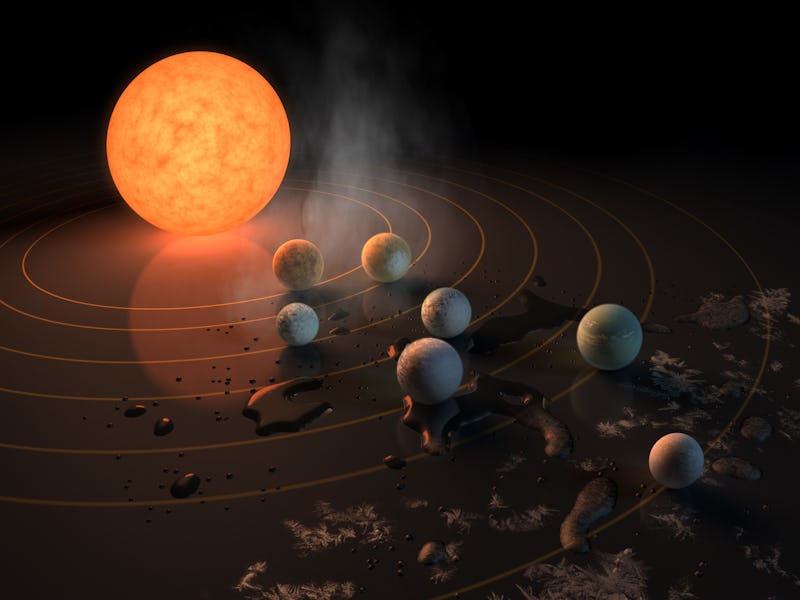When we look at the night sky, we see a large glowing moon and tiny stars and planets. But if you’re sitting on one planet orbiting the nearby TRAPPIST-1 star, the six other planets in the system would appear as massive moon-sized globes. In fact, these planets are so close that some scientists think microbes could potentially hop from planet to planet and colonize the system outright.
In a recent study submitted for publication, researchers from Harvard University created a model to estimate the probability of interplanetary panspermia in the TRAPPIST-1 system. What this means is extraterrestrial life may have been seeded multiple planets over time, allowing them to inhabit each one and even evolve individually over time. In other words, if one planet on the TRAPPIST-1 system bear life, then it’s likely the other planets in the system bear life as well.
“During the transfer between one to another, microbes and living organisms survive the harsh conditions of space,” co-author Avi Loeb, an astronomer at Harvard University, tells Inverse. “They could end up landing on a new planet and seeding life there as well.”
With the recent discovery of seven Earth-like planets orbiting TRAPPIST-1, it’s easy to imagine intergalactic empires, where aliens can take vacations to neighboring planets. According to these researchers, if one of these TRAPPIST-1 planets contains life, it’s likely that others do as well.
Loeb and his colleague believe there’s a higher chance life evolved from inorganic substances in the TRAPPIST-1 system than the solar system itself. These microbes may have traveled from planet to planet by hitching a ride inside rocks. When an object collides into a planet, it sends these rocks flying into space — and possibly will wind up on another planet and seed life there.
What’s more, if life exists in the TRAPPIST-1 system, it’s probably more diverse. Compared to the solar system, more species of life likely evolved in the TRAPPIST-1 system because of interplanetary migration of life. Of course, this model depends on whether there actually is life in the system in the first place.
“In this TRAPPIST-1 system, we don’t know if there’s a cloud of asteroids that impacted those planets,” Loeb says. “More importantly, if one of these planets developed life, we don’t know that. We don’t know if planets have atmospheres at the moment…All we’re saying in this paper is that if life exists on one planet, it’s likely that it exists on another planet in the system.”
The panspermia theory applies to Earth as well — perhaps compounds from comets seeded the planet with the building blocks for life. Researchers actually found that panspermia is more likely to occur in the TRAPPIST-1 planets than between Earth and Mars, especially since the TRAPPIST-1 planets are so close.
In fact, travel time between TRAPPIST-1 planets is 100 times less than the planets in our solar system. The chances of a rock with life from one TRAPPIST-1 planet hitting another is 20 times greater than the chances in our solar system. Altogether, the chance of delivery and survival of life on a rock is 2,000 times higher in TRAPPIST-1.
Panspermia for the TRAPPIST-1 planets would essentially appear like an astronomical version of island-hopping. The researchers created models based on the way species on Earth migrated between islands. This concept works better if the planets have robust atmospheres which could allow for liquid surface water.
“What we did in the paper is make the analogy with islands,” Loeb says. “People have studied over the years immigration of species between islands. For example, Galapagos. There were models developed for the transfer of life from one to another.”
Discovering whether these planets — especially the three habitable ones — have atmospheres would be the next step. The James Webb Space Telescope will be looking for atmospheres in the TRAPPIST-1 planets, which will help scientists analyze potential biosignatures and narrow down on other possible signs of life in the system.
“We have three planets in the habitable zone, and that gives us three times of rolling the dice,” Loeb says. “In the solar system, we just have Earth, but there we have three rollings of the dice, and what our paper says is the success of one could affect the others.”
